Understanding HIV Disease: Key Factors, Prevention Strategies, and Role of Nurses and ART Therapy
VerifiedAdded on 2023/06/03
|13
|4474
|291
AI Summary
This essay discusses the key factors that influence the issue of HIV, the role of nurses and ART therapy for prevention, and different strategies for HIV prevention. It also explains the signs and symptoms of HIV, how it spreads, and the different stages of HIV infection.
Contribute Materials
Your contribution can guide someone’s learning journey. Share your
documents today.

HIV disease
Secure Best Marks with AI Grader
Need help grading? Try our AI Grader for instant feedback on your assignments.
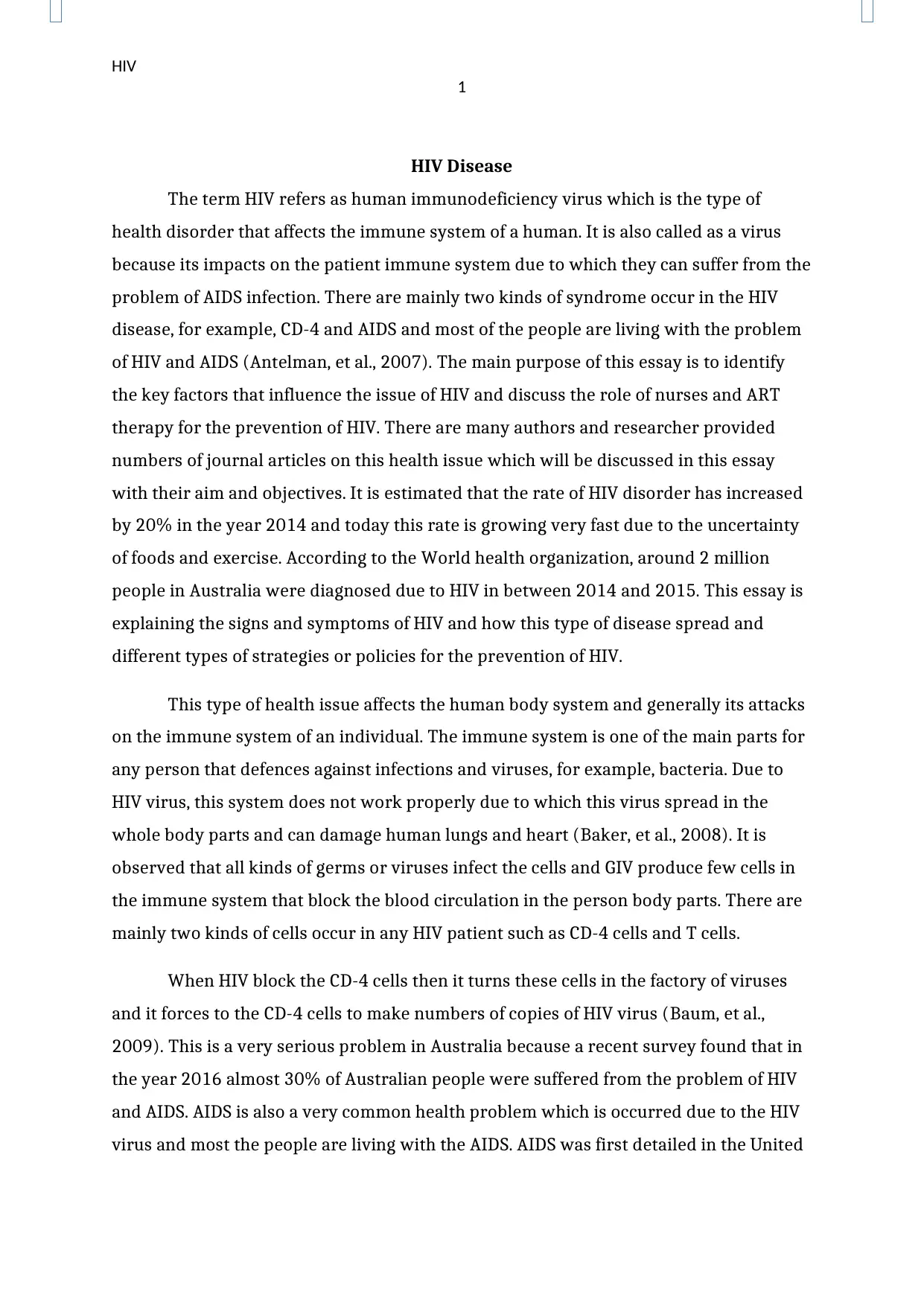
HIV
1
HIV Disease
The term HIV refers as human immunodeficiency virus which is the type of
health disorder that affects the immune system of a human. It is also called as a virus
because its impacts on the patient immune system due to which they can suffer from the
problem of AIDS infection. There are mainly two kinds of syndrome occur in the HIV
disease, for example, CD-4 and AIDS and most of the people are living with the problem
of HIV and AIDS (Antelman, et al., 2007). The main purpose of this essay is to identify
the key factors that influence the issue of HIV and discuss the role of nurses and ART
therapy for the prevention of HIV. There are many authors and researcher provided
numbers of journal articles on this health issue which will be discussed in this essay
with their aim and objectives. It is estimated that the rate of HIV disorder has increased
by 20% in the year 2014 and today this rate is growing very fast due to the uncertainty
of foods and exercise. According to the World health organization, around 2 million
people in Australia were diagnosed due to HIV in between 2014 and 2015. This essay is
explaining the signs and symptoms of HIV and how this type of disease spread and
different types of strategies or policies for the prevention of HIV.
This type of health issue affects the human body system and generally its attacks
on the immune system of an individual. The immune system is one of the main parts for
any person that defences against infections and viruses, for example, bacteria. Due to
HIV virus, this system does not work properly due to which this virus spread in the
whole body parts and can damage human lungs and heart (Baker, et al., 2008). It is
observed that all kinds of germs or viruses infect the cells and GIV produce few cells in
the immune system that block the blood circulation in the person body parts. There are
mainly two kinds of cells occur in any HIV patient such as CD-4 cells and T cells.
When HIV block the CD-4 cells then it turns these cells in the factory of viruses
and it forces to the CD-4 cells to make numbers of copies of HIV virus (Baum, et al.,
2009). This is a very serious problem in Australia because a recent survey found that in
the year 2016 almost 30% of Australian people were suffered from the problem of HIV
and AIDS. AIDS is also a very common health problem which is occurred due to the HIV
virus and most the people are living with the AIDS. AIDS was first detailed in the United
1
HIV Disease
The term HIV refers as human immunodeficiency virus which is the type of
health disorder that affects the immune system of a human. It is also called as a virus
because its impacts on the patient immune system due to which they can suffer from the
problem of AIDS infection. There are mainly two kinds of syndrome occur in the HIV
disease, for example, CD-4 and AIDS and most of the people are living with the problem
of HIV and AIDS (Antelman, et al., 2007). The main purpose of this essay is to identify
the key factors that influence the issue of HIV and discuss the role of nurses and ART
therapy for the prevention of HIV. There are many authors and researcher provided
numbers of journal articles on this health issue which will be discussed in this essay
with their aim and objectives. It is estimated that the rate of HIV disorder has increased
by 20% in the year 2014 and today this rate is growing very fast due to the uncertainty
of foods and exercise. According to the World health organization, around 2 million
people in Australia were diagnosed due to HIV in between 2014 and 2015. This essay is
explaining the signs and symptoms of HIV and how this type of disease spread and
different types of strategies or policies for the prevention of HIV.
This type of health issue affects the human body system and generally its attacks
on the immune system of an individual. The immune system is one of the main parts for
any person that defences against infections and viruses, for example, bacteria. Due to
HIV virus, this system does not work properly due to which this virus spread in the
whole body parts and can damage human lungs and heart (Baker, et al., 2008). It is
observed that all kinds of germs or viruses infect the cells and GIV produce few cells in
the immune system that block the blood circulation in the person body parts. There are
mainly two kinds of cells occur in any HIV patient such as CD-4 cells and T cells.
When HIV block the CD-4 cells then it turns these cells in the factory of viruses
and it forces to the CD-4 cells to make numbers of copies of HIV virus (Baum, et al.,
2009). This is a very serious problem in Australia because a recent survey found that in
the year 2016 almost 30% of Australian people were suffered from the problem of HIV
and AIDS. AIDS is also a very common health problem which is occurred due to the HIV
virus and most the people are living with the AIDS. AIDS was first detailed in the United
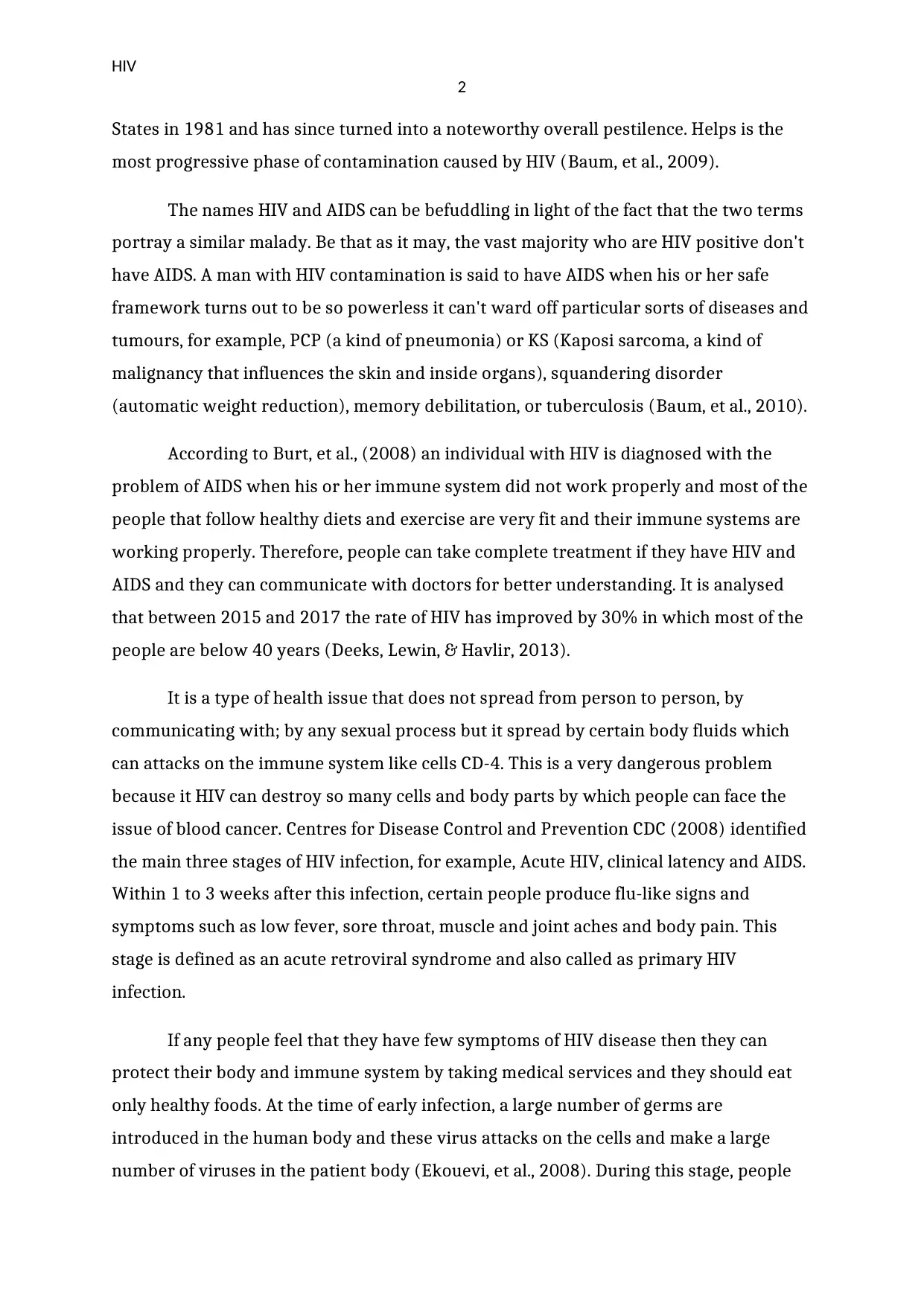
HIV
2
States in 1981 and has since turned into a noteworthy overall pestilence. Helps is the
most progressive phase of contamination caused by HIV (Baum, et al., 2009).
The names HIV and AIDS can be befuddling in light of the fact that the two terms
portray a similar malady. Be that as it may, the vast majority who are HIV positive don't
have AIDS. A man with HIV contamination is said to have AIDS when his or her safe
framework turns out to be so powerless it can't ward off particular sorts of diseases and
tumours, for example, PCP (a kind of pneumonia) or KS (Kaposi sarcoma, a kind of
malignancy that influences the skin and inside organs), squandering disorder
(automatic weight reduction), memory debilitation, or tuberculosis (Baum, et al., 2010).
According to Burt, et al., (2008) an individual with HIV is diagnosed with the
problem of AIDS when his or her immune system did not work properly and most of the
people that follow healthy diets and exercise are very fit and their immune systems are
working properly. Therefore, people can take complete treatment if they have HIV and
AIDS and they can communicate with doctors for better understanding. It is analysed
that between 2015 and 2017 the rate of HIV has improved by 30% in which most of the
people are below 40 years (Deeks, Lewin, & Havlir, 2013).
It is a type of health issue that does not spread from person to person, by
communicating with; by any sexual process but it spread by certain body fluids which
can attacks on the immune system like cells CD-4. This is a very dangerous problem
because it HIV can destroy so many cells and body parts by which people can face the
issue of blood cancer. Centres for Disease Control and Prevention CDC (2008) identified
the main three stages of HIV infection, for example, Acute HIV, clinical latency and AIDS.
Within 1 to 3 weeks after this infection, certain people produce flu-like signs and
symptoms such as low fever, sore throat, muscle and joint aches and body pain. This
stage is defined as an acute retroviral syndrome and also called as primary HIV
infection.
If any people feel that they have few symptoms of HIV disease then they can
protect their body and immune system by taking medical services and they should eat
only healthy foods. At the time of early infection, a large number of germs are
introduced in the human body and these virus attacks on the cells and make a large
number of viruses in the patient body (Ekouevi, et al., 2008). During this stage, people
2
States in 1981 and has since turned into a noteworthy overall pestilence. Helps is the
most progressive phase of contamination caused by HIV (Baum, et al., 2009).
The names HIV and AIDS can be befuddling in light of the fact that the two terms
portray a similar malady. Be that as it may, the vast majority who are HIV positive don't
have AIDS. A man with HIV contamination is said to have AIDS when his or her safe
framework turns out to be so powerless it can't ward off particular sorts of diseases and
tumours, for example, PCP (a kind of pneumonia) or KS (Kaposi sarcoma, a kind of
malignancy that influences the skin and inside organs), squandering disorder
(automatic weight reduction), memory debilitation, or tuberculosis (Baum, et al., 2010).
According to Burt, et al., (2008) an individual with HIV is diagnosed with the
problem of AIDS when his or her immune system did not work properly and most of the
people that follow healthy diets and exercise are very fit and their immune systems are
working properly. Therefore, people can take complete treatment if they have HIV and
AIDS and they can communicate with doctors for better understanding. It is analysed
that between 2015 and 2017 the rate of HIV has improved by 30% in which most of the
people are below 40 years (Deeks, Lewin, & Havlir, 2013).
It is a type of health issue that does not spread from person to person, by
communicating with; by any sexual process but it spread by certain body fluids which
can attacks on the immune system like cells CD-4. This is a very dangerous problem
because it HIV can destroy so many cells and body parts by which people can face the
issue of blood cancer. Centres for Disease Control and Prevention CDC (2008) identified
the main three stages of HIV infection, for example, Acute HIV, clinical latency and AIDS.
Within 1 to 3 weeks after this infection, certain people produce flu-like signs and
symptoms such as low fever, sore throat, muscle and joint aches and body pain. This
stage is defined as an acute retroviral syndrome and also called as primary HIV
infection.
If any people feel that they have few symptoms of HIV disease then they can
protect their body and immune system by taking medical services and they should eat
only healthy foods. At the time of early infection, a large number of germs are
introduced in the human body and these virus attacks on the cells and make a large
number of viruses in the patient body (Ekouevi, et al., 2008). During this stage, people
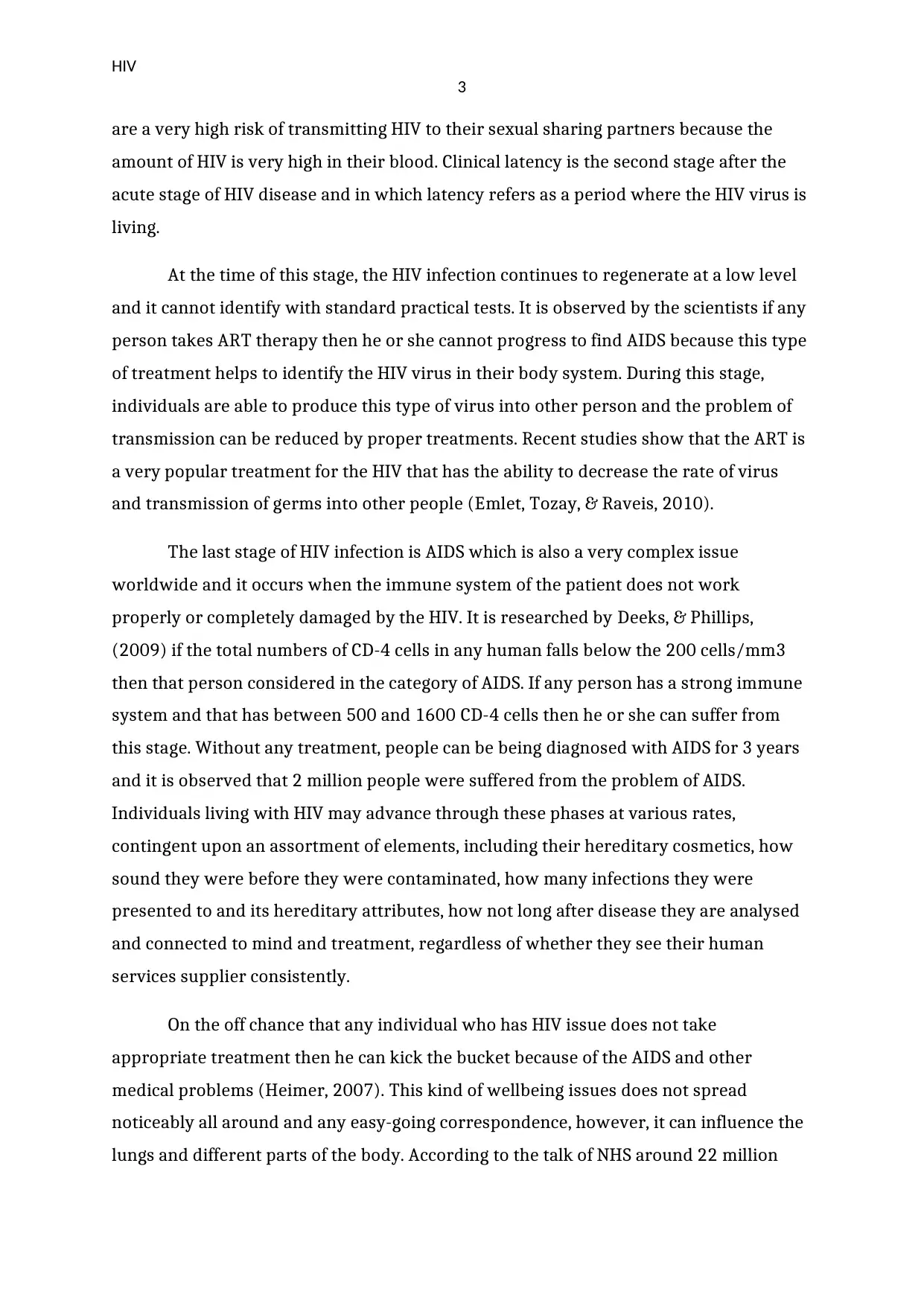
HIV
3
are a very high risk of transmitting HIV to their sexual sharing partners because the
amount of HIV is very high in their blood. Clinical latency is the second stage after the
acute stage of HIV disease and in which latency refers as a period where the HIV virus is
living.
At the time of this stage, the HIV infection continues to regenerate at a low level
and it cannot identify with standard practical tests. It is observed by the scientists if any
person takes ART therapy then he or she cannot progress to find AIDS because this type
of treatment helps to identify the HIV virus in their body system. During this stage,
individuals are able to produce this type of virus into other person and the problem of
transmission can be reduced by proper treatments. Recent studies show that the ART is
a very popular treatment for the HIV that has the ability to decrease the rate of virus
and transmission of germs into other people (Emlet, Tozay, & Raveis, 2010).
The last stage of HIV infection is AIDS which is also a very complex issue
worldwide and it occurs when the immune system of the patient does not work
properly or completely damaged by the HIV. It is researched by Deeks, & Phillips,
(2009) if the total numbers of CD-4 cells in any human falls below the 200 cells/mm3
then that person considered in the category of AIDS. If any person has a strong immune
system and that has between 500 and 1600 CD-4 cells then he or she can suffer from
this stage. Without any treatment, people can be being diagnosed with AIDS for 3 years
and it is observed that 2 million people were suffered from the problem of AIDS.
Individuals living with HIV may advance through these phases at various rates,
contingent upon an assortment of elements, including their hereditary cosmetics, how
sound they were before they were contaminated, how many infections they were
presented to and its hereditary attributes, how not long after disease they are analysed
and connected to mind and treatment, regardless of whether they see their human
services supplier consistently.
On the off chance that any individual who has HIV issue does not take
appropriate treatment then he can kick the bucket because of the AIDS and other
medical problems (Heimer, 2007). This kind of wellbeing issues does not spread
noticeably all around and any easy-going correspondence, however, it can influence the
lungs and different parts of the body. According to the talk of NHS around 22 million
3
are a very high risk of transmitting HIV to their sexual sharing partners because the
amount of HIV is very high in their blood. Clinical latency is the second stage after the
acute stage of HIV disease and in which latency refers as a period where the HIV virus is
living.
At the time of this stage, the HIV infection continues to regenerate at a low level
and it cannot identify with standard practical tests. It is observed by the scientists if any
person takes ART therapy then he or she cannot progress to find AIDS because this type
of treatment helps to identify the HIV virus in their body system. During this stage,
individuals are able to produce this type of virus into other person and the problem of
transmission can be reduced by proper treatments. Recent studies show that the ART is
a very popular treatment for the HIV that has the ability to decrease the rate of virus
and transmission of germs into other people (Emlet, Tozay, & Raveis, 2010).
The last stage of HIV infection is AIDS which is also a very complex issue
worldwide and it occurs when the immune system of the patient does not work
properly or completely damaged by the HIV. It is researched by Deeks, & Phillips,
(2009) if the total numbers of CD-4 cells in any human falls below the 200 cells/mm3
then that person considered in the category of AIDS. If any person has a strong immune
system and that has between 500 and 1600 CD-4 cells then he or she can suffer from
this stage. Without any treatment, people can be being diagnosed with AIDS for 3 years
and it is observed that 2 million people were suffered from the problem of AIDS.
Individuals living with HIV may advance through these phases at various rates,
contingent upon an assortment of elements, including their hereditary cosmetics, how
sound they were before they were contaminated, how many infections they were
presented to and its hereditary attributes, how not long after disease they are analysed
and connected to mind and treatment, regardless of whether they see their human
services supplier consistently.
On the off chance that any individual who has HIV issue does not take
appropriate treatment then he can kick the bucket because of the AIDS and other
medical problems (Heimer, 2007). This kind of wellbeing issues does not spread
noticeably all around and any easy-going correspondence, however, it can influence the
lungs and different parts of the body. According to the talk of NHS around 22 million
Secure Best Marks with AI Grader
Need help grading? Try our AI Grader for instant feedback on your assignments.
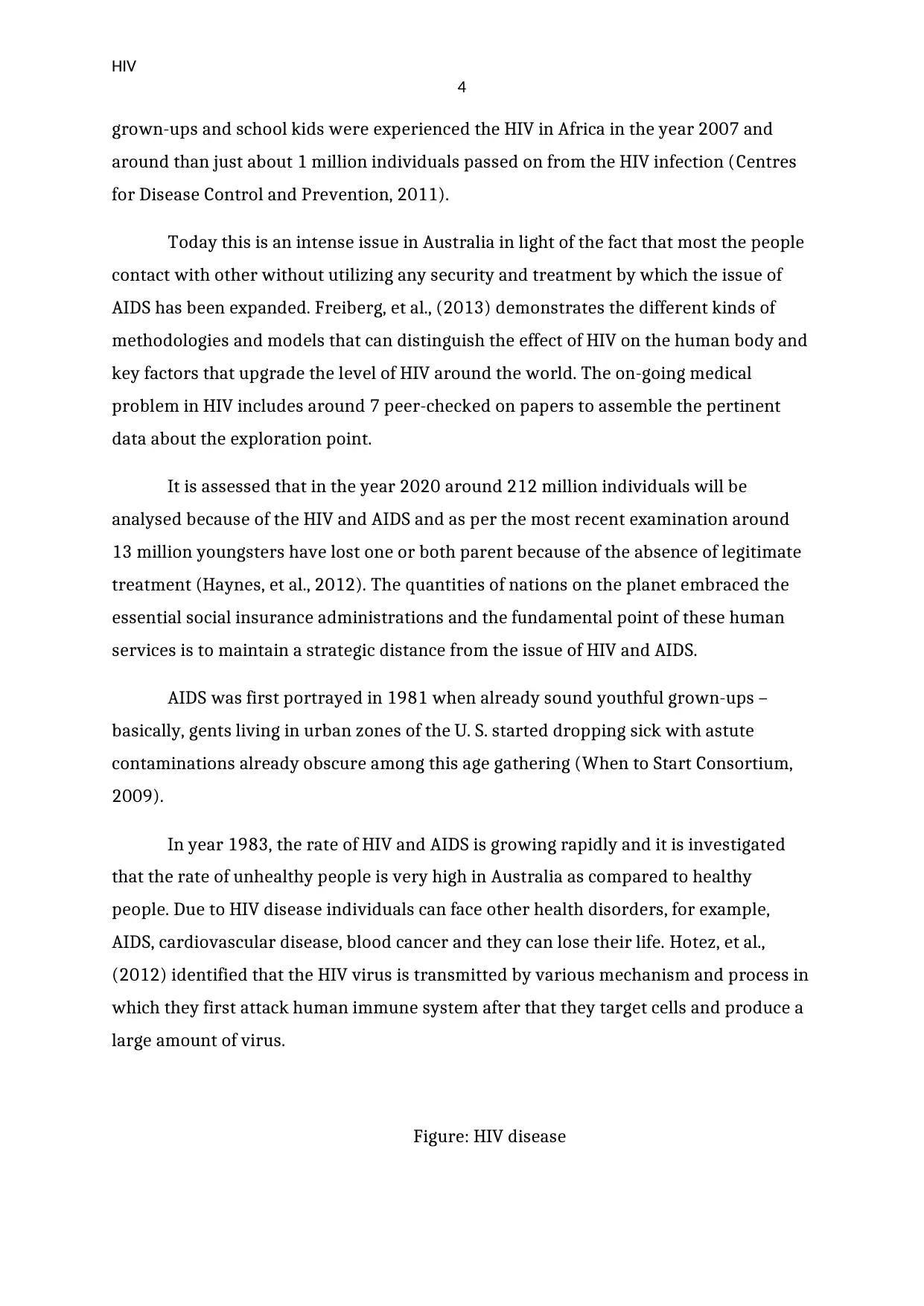
HIV
4
grown-ups and school kids were experienced the HIV in Africa in the year 2007 and
around than just about 1 million individuals passed on from the HIV infection (Centres
for Disease Control and Prevention, 2011).
Today this is an intense issue in Australia in light of the fact that most the people
contact with other without utilizing any security and treatment by which the issue of
AIDS has been expanded. Freiberg, et al., (2013) demonstrates the different kinds of
methodologies and models that can distinguish the effect of HIV on the human body and
key factors that upgrade the level of HIV around the world. The on-going medical
problem in HIV includes around 7 peer-checked on papers to assemble the pertinent
data about the exploration point.
It is assessed that in the year 2020 around 212 million individuals will be
analysed because of the HIV and AIDS and as per the most recent examination around
13 million youngsters have lost one or both parent because of the absence of legitimate
treatment (Haynes, et al., 2012). The quantities of nations on the planet embraced the
essential social insurance administrations and the fundamental point of these human
services is to maintain a strategic distance from the issue of HIV and AIDS.
AIDS was first portrayed in 1981 when already sound youthful grown-ups –
basically, gents living in urban zones of the U. S. started dropping sick with astute
contaminations already obscure among this age gathering (When to Start Consortium,
2009).
In year 1983, the rate of HIV and AIDS is growing rapidly and it is investigated
that the rate of unhealthy people is very high in Australia as compared to healthy
people. Due to HIV disease individuals can face other health disorders, for example,
AIDS, cardiovascular disease, blood cancer and they can lose their life. Hotez, et al.,
(2012) identified that the HIV virus is transmitted by various mechanism and process in
which they first attack human immune system after that they target cells and produce a
large amount of virus.
Figure: HIV disease
4
grown-ups and school kids were experienced the HIV in Africa in the year 2007 and
around than just about 1 million individuals passed on from the HIV infection (Centres
for Disease Control and Prevention, 2011).
Today this is an intense issue in Australia in light of the fact that most the people
contact with other without utilizing any security and treatment by which the issue of
AIDS has been expanded. Freiberg, et al., (2013) demonstrates the different kinds of
methodologies and models that can distinguish the effect of HIV on the human body and
key factors that upgrade the level of HIV around the world. The on-going medical
problem in HIV includes around 7 peer-checked on papers to assemble the pertinent
data about the exploration point.
It is assessed that in the year 2020 around 212 million individuals will be
analysed because of the HIV and AIDS and as per the most recent examination around
13 million youngsters have lost one or both parent because of the absence of legitimate
treatment (Haynes, et al., 2012). The quantities of nations on the planet embraced the
essential social insurance administrations and the fundamental point of these human
services is to maintain a strategic distance from the issue of HIV and AIDS.
AIDS was first portrayed in 1981 when already sound youthful grown-ups –
basically, gents living in urban zones of the U. S. started dropping sick with astute
contaminations already obscure among this age gathering (When to Start Consortium,
2009).
In year 1983, the rate of HIV and AIDS is growing rapidly and it is investigated
that the rate of unhealthy people is very high in Australia as compared to healthy
people. Due to HIV disease individuals can face other health disorders, for example,
AIDS, cardiovascular disease, blood cancer and they can lose their life. Hotez, et al.,
(2012) identified that the HIV virus is transmitted by various mechanism and process in
which they first attack human immune system after that they target cells and produce a
large amount of virus.
Figure: HIV disease
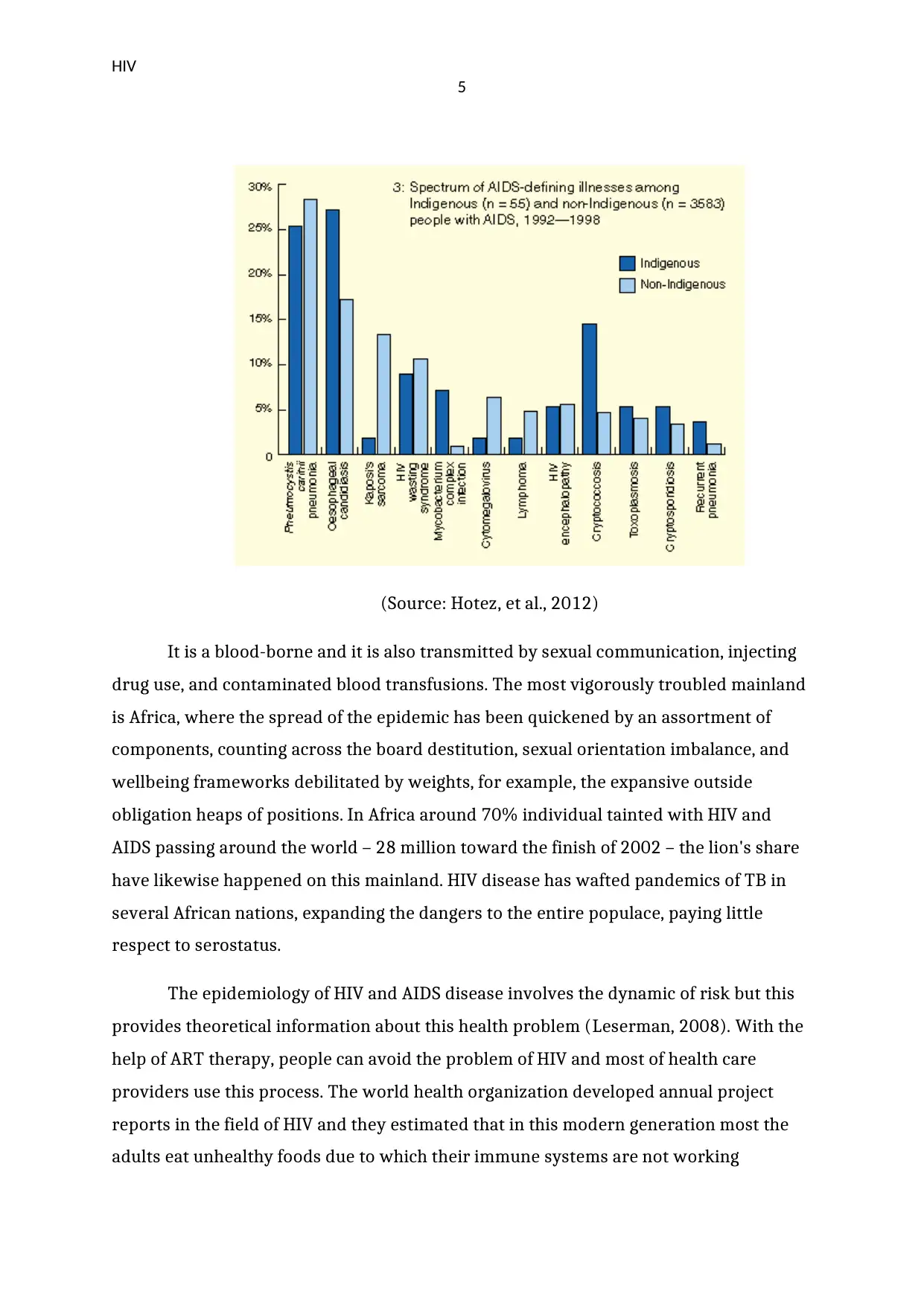
HIV
5
(Source: Hotez, et al., 2012)
It is a blood-borne and it is also transmitted by sexual communication, injecting
drug use, and contaminated blood transfusions. The most vigorously troubled mainland
is Africa, where the spread of the epidemic has been quickened by an assortment of
components, counting across the board destitution, sexual orientation imbalance, and
wellbeing frameworks debilitated by weights, for example, the expansive outside
obligation heaps of positions. In Africa around 70% individual tainted with HIV and
AIDS passing around the world – 28 million toward the finish of 2002 – the lion's share
have likewise happened on this mainland. HIV disease has wafted pandemics of TB in
several African nations, expanding the dangers to the entire populace, paying little
respect to serostatus.
The epidemiology of HIV and AIDS disease involves the dynamic of risk but this
provides theoretical information about this health problem (Leserman, 2008). With the
help of ART therapy, people can avoid the problem of HIV and most of health care
providers use this process. The world health organization developed annual project
reports in the field of HIV and they estimated that in this modern generation most the
adults eat unhealthy foods due to which their immune systems are not working
5
(Source: Hotez, et al., 2012)
It is a blood-borne and it is also transmitted by sexual communication, injecting
drug use, and contaminated blood transfusions. The most vigorously troubled mainland
is Africa, where the spread of the epidemic has been quickened by an assortment of
components, counting across the board destitution, sexual orientation imbalance, and
wellbeing frameworks debilitated by weights, for example, the expansive outside
obligation heaps of positions. In Africa around 70% individual tainted with HIV and
AIDS passing around the world – 28 million toward the finish of 2002 – the lion's share
have likewise happened on this mainland. HIV disease has wafted pandemics of TB in
several African nations, expanding the dangers to the entire populace, paying little
respect to serostatus.
The epidemiology of HIV and AIDS disease involves the dynamic of risk but this
provides theoretical information about this health problem (Leserman, 2008). With the
help of ART therapy, people can avoid the problem of HIV and most of health care
providers use this process. The world health organization developed annual project
reports in the field of HIV and they estimated that in this modern generation most the
adults eat unhealthy foods due to which their immune systems are not working
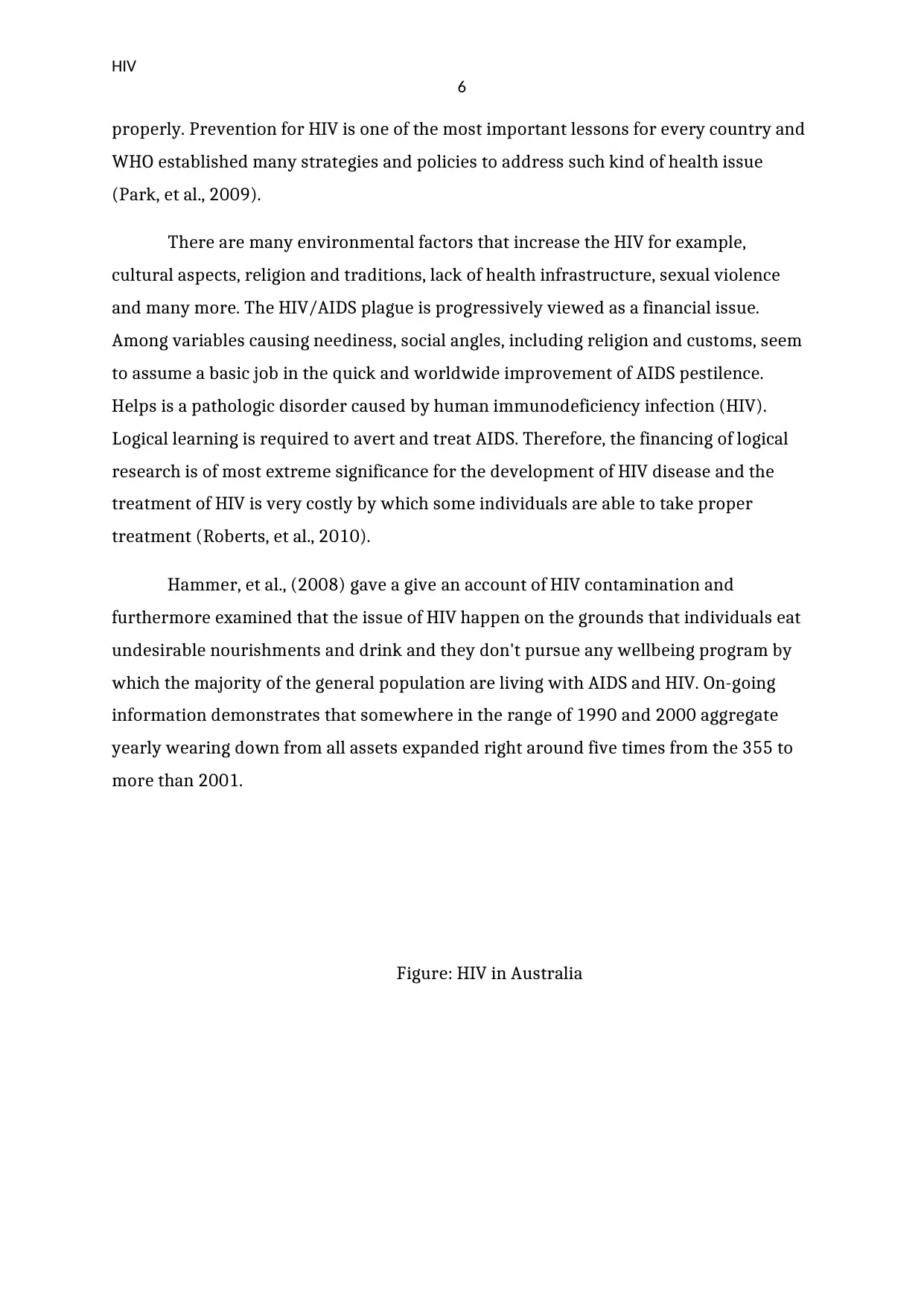
HIV
6
properly. Prevention for HIV is one of the most important lessons for every country and
WHO established many strategies and policies to address such kind of health issue
(Park, et al., 2009).
There are many environmental factors that increase the HIV for example,
cultural aspects, religion and traditions, lack of health infrastructure, sexual violence
and many more. The HIV/AIDS plague is progressively viewed as a financial issue.
Among variables causing neediness, social angles, including religion and customs, seem
to assume a basic job in the quick and worldwide improvement of AIDS pestilence.
Helps is a pathologic disorder caused by human immunodeficiency infection (HIV).
Logical learning is required to avert and treat AIDS. Therefore, the financing of logical
research is of most extreme significance for the development of HIV disease and the
treatment of HIV is very costly by which some individuals are able to take proper
treatment (Roberts, et al., 2010).
Hammer, et al., (2008) gave a give an account of HIV contamination and
furthermore examined that the issue of HIV happen on the grounds that individuals eat
undesirable nourishments and drink and they don't pursue any wellbeing program by
which the majority of the general population are living with AIDS and HIV. On-going
information demonstrates that somewhere in the range of 1990 and 2000 aggregate
yearly wearing down from all assets expanded right around five times from the 355 to
more than 2001.
Figure: HIV in Australia
6
properly. Prevention for HIV is one of the most important lessons for every country and
WHO established many strategies and policies to address such kind of health issue
(Park, et al., 2009).
There are many environmental factors that increase the HIV for example,
cultural aspects, religion and traditions, lack of health infrastructure, sexual violence
and many more. The HIV/AIDS plague is progressively viewed as a financial issue.
Among variables causing neediness, social angles, including religion and customs, seem
to assume a basic job in the quick and worldwide improvement of AIDS pestilence.
Helps is a pathologic disorder caused by human immunodeficiency infection (HIV).
Logical learning is required to avert and treat AIDS. Therefore, the financing of logical
research is of most extreme significance for the development of HIV disease and the
treatment of HIV is very costly by which some individuals are able to take proper
treatment (Roberts, et al., 2010).
Hammer, et al., (2008) gave a give an account of HIV contamination and
furthermore examined that the issue of HIV happen on the grounds that individuals eat
undesirable nourishments and drink and they don't pursue any wellbeing program by
which the majority of the general population are living with AIDS and HIV. On-going
information demonstrates that somewhere in the range of 1990 and 2000 aggregate
yearly wearing down from all assets expanded right around five times from the 355 to
more than 2001.
Figure: HIV in Australia
Paraphrase This Document
Need a fresh take? Get an instant paraphrase of this document with our AI Paraphraser
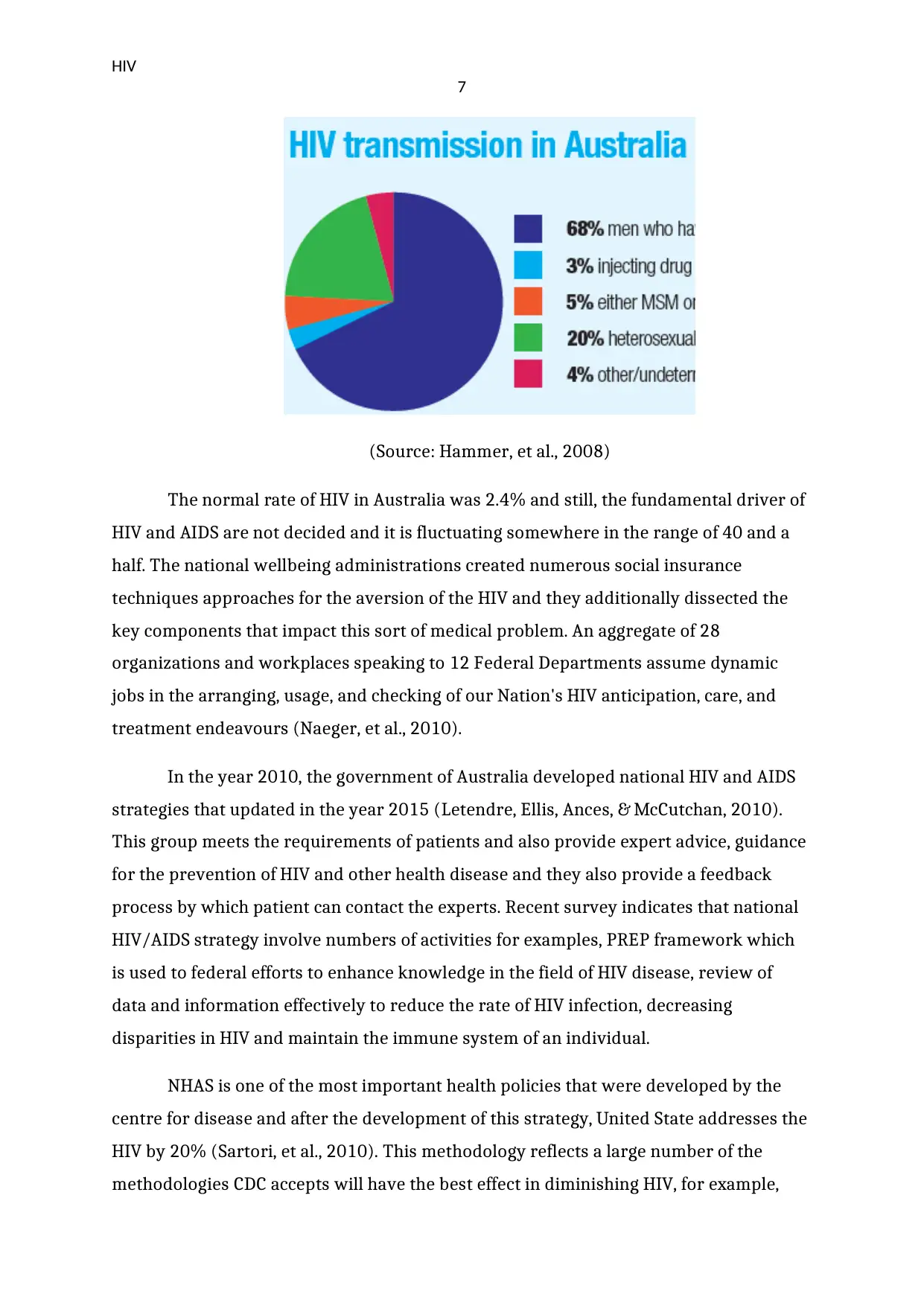
HIV
7
(Source: Hammer, et al., 2008)
The normal rate of HIV in Australia was 2.4% and still, the fundamental driver of
HIV and AIDS are not decided and it is fluctuating somewhere in the range of 40 and a
half. The national wellbeing administrations created numerous social insurance
techniques approaches for the aversion of the HIV and they additionally dissected the
key components that impact this sort of medical problem. An aggregate of 28
organizations and workplaces speaking to 12 Federal Departments assume dynamic
jobs in the arranging, usage, and checking of our Nation's HIV anticipation, care, and
treatment endeavours (Naeger, et al., 2010).
In the year 2010, the government of Australia developed national HIV and AIDS
strategies that updated in the year 2015 (Letendre, Ellis, Ances, & McCutchan, 2010).
This group meets the requirements of patients and also provide expert advice, guidance
for the prevention of HIV and other health disease and they also provide a feedback
process by which patient can contact the experts. Recent survey indicates that national
HIV/AIDS strategy involve numbers of activities for examples, PREP framework which
is used to federal efforts to enhance knowledge in the field of HIV disease, review of
data and information effectively to reduce the rate of HIV infection, decreasing
disparities in HIV and maintain the immune system of an individual.
NHAS is one of the most important health policies that were developed by the
centre for disease and after the development of this strategy, United State addresses the
HIV by 20% (Sartori, et al., 2010). This methodology reflects a large number of the
methodologies CDC accepts will have the best effect in diminishing HIV, for example,
7
(Source: Hammer, et al., 2008)
The normal rate of HIV in Australia was 2.4% and still, the fundamental driver of
HIV and AIDS are not decided and it is fluctuating somewhere in the range of 40 and a
half. The national wellbeing administrations created numerous social insurance
techniques approaches for the aversion of the HIV and they additionally dissected the
key components that impact this sort of medical problem. An aggregate of 28
organizations and workplaces speaking to 12 Federal Departments assume dynamic
jobs in the arranging, usage, and checking of our Nation's HIV anticipation, care, and
treatment endeavours (Naeger, et al., 2010).
In the year 2010, the government of Australia developed national HIV and AIDS
strategies that updated in the year 2015 (Letendre, Ellis, Ances, & McCutchan, 2010).
This group meets the requirements of patients and also provide expert advice, guidance
for the prevention of HIV and other health disease and they also provide a feedback
process by which patient can contact the experts. Recent survey indicates that national
HIV/AIDS strategy involve numbers of activities for examples, PREP framework which
is used to federal efforts to enhance knowledge in the field of HIV disease, review of
data and information effectively to reduce the rate of HIV infection, decreasing
disparities in HIV and maintain the immune system of an individual.
NHAS is one of the most important health policies that were developed by the
centre for disease and after the development of this strategy, United State addresses the
HIV by 20% (Sartori, et al., 2010). This methodology reflects a large number of the
methodologies CDC accepts will have the best effect in diminishing HIV, for example,
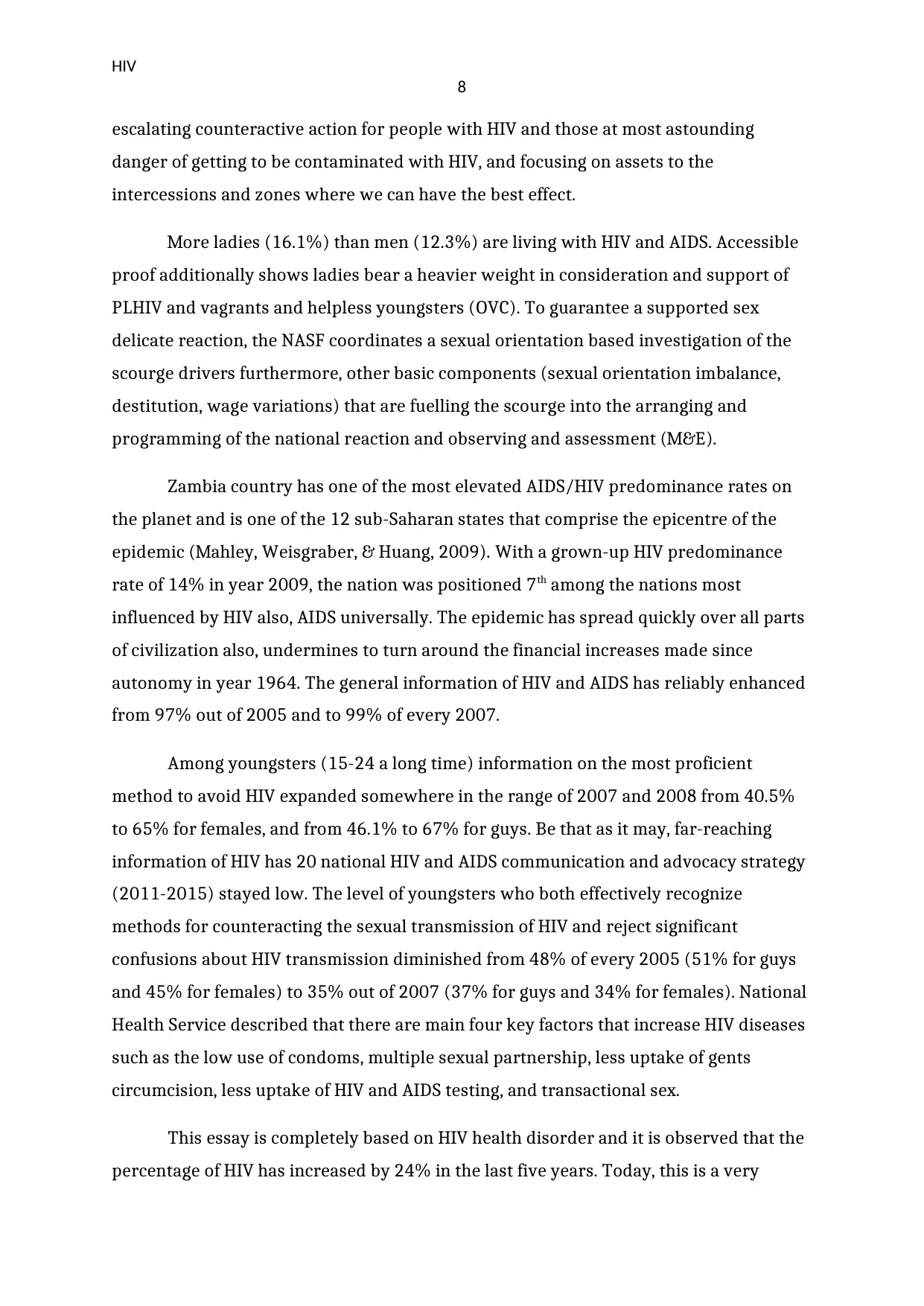
HIV
8
escalating counteractive action for people with HIV and those at most astounding
danger of getting to be contaminated with HIV, and focusing on assets to the
intercessions and zones where we can have the best effect.
More ladies (16.1%) than men (12.3%) are living with HIV and AIDS. Accessible
proof additionally shows ladies bear a heavier weight in consideration and support of
PLHIV and vagrants and helpless youngsters (OVC). To guarantee a supported sex
delicate reaction, the NASF coordinates a sexual orientation based investigation of the
scourge drivers furthermore, other basic components (sexual orientation imbalance,
destitution, wage variations) that are fuelling the scourge into the arranging and
programming of the national reaction and observing and assessment (M&E).
Zambia country has one of the most elevated AIDS/HIV predominance rates on
the planet and is one of the 12 sub-Saharan states that comprise the epicentre of the
epidemic (Mahley, Weisgraber, & Huang, 2009). With a grown-up HIV predominance
rate of 14% in year 2009, the nation was positioned 7th among the nations most
influenced by HIV also, AIDS universally. The epidemic has spread quickly over all parts
of civilization also, undermines to turn around the financial increases made since
autonomy in year 1964. The general information of HIV and AIDS has reliably enhanced
from 97% out of 2005 and to 99% of every 2007.
Among youngsters (15-24 a long time) information on the most proficient
method to avoid HIV expanded somewhere in the range of 2007 and 2008 from 40.5%
to 65% for females, and from 46.1% to 67% for guys. Be that as it may, far-reaching
information of HIV has 20 national HIV and AIDS communication and advocacy strategy
(2011-2015) stayed low. The level of youngsters who both effectively recognize
methods for counteracting the sexual transmission of HIV and reject significant
confusions about HIV transmission diminished from 48% of every 2005 (51% for guys
and 45% for females) to 35% out of 2007 (37% for guys and 34% for females). National
Health Service described that there are main four key factors that increase HIV diseases
such as the low use of condoms, multiple sexual partnership, less uptake of gents
circumcision, less uptake of HIV and AIDS testing, and transactional sex.
This essay is completely based on HIV health disorder and it is observed that the
percentage of HIV has increased by 24% in the last five years. Today, this is a very
8
escalating counteractive action for people with HIV and those at most astounding
danger of getting to be contaminated with HIV, and focusing on assets to the
intercessions and zones where we can have the best effect.
More ladies (16.1%) than men (12.3%) are living with HIV and AIDS. Accessible
proof additionally shows ladies bear a heavier weight in consideration and support of
PLHIV and vagrants and helpless youngsters (OVC). To guarantee a supported sex
delicate reaction, the NASF coordinates a sexual orientation based investigation of the
scourge drivers furthermore, other basic components (sexual orientation imbalance,
destitution, wage variations) that are fuelling the scourge into the arranging and
programming of the national reaction and observing and assessment (M&E).
Zambia country has one of the most elevated AIDS/HIV predominance rates on
the planet and is one of the 12 sub-Saharan states that comprise the epicentre of the
epidemic (Mahley, Weisgraber, & Huang, 2009). With a grown-up HIV predominance
rate of 14% in year 2009, the nation was positioned 7th among the nations most
influenced by HIV also, AIDS universally. The epidemic has spread quickly over all parts
of civilization also, undermines to turn around the financial increases made since
autonomy in year 1964. The general information of HIV and AIDS has reliably enhanced
from 97% out of 2005 and to 99% of every 2007.
Among youngsters (15-24 a long time) information on the most proficient
method to avoid HIV expanded somewhere in the range of 2007 and 2008 from 40.5%
to 65% for females, and from 46.1% to 67% for guys. Be that as it may, far-reaching
information of HIV has 20 national HIV and AIDS communication and advocacy strategy
(2011-2015) stayed low. The level of youngsters who both effectively recognize
methods for counteracting the sexual transmission of HIV and reject significant
confusions about HIV transmission diminished from 48% of every 2005 (51% for guys
and 45% for females) to 35% out of 2007 (37% for guys and 34% for females). National
Health Service described that there are main four key factors that increase HIV diseases
such as the low use of condoms, multiple sexual partnership, less uptake of gents
circumcision, less uptake of HIV and AIDS testing, and transactional sex.
This essay is completely based on HIV health disorder and it is observed that the
percentage of HIV has increased by 24% in the last five years. Today, this is a very
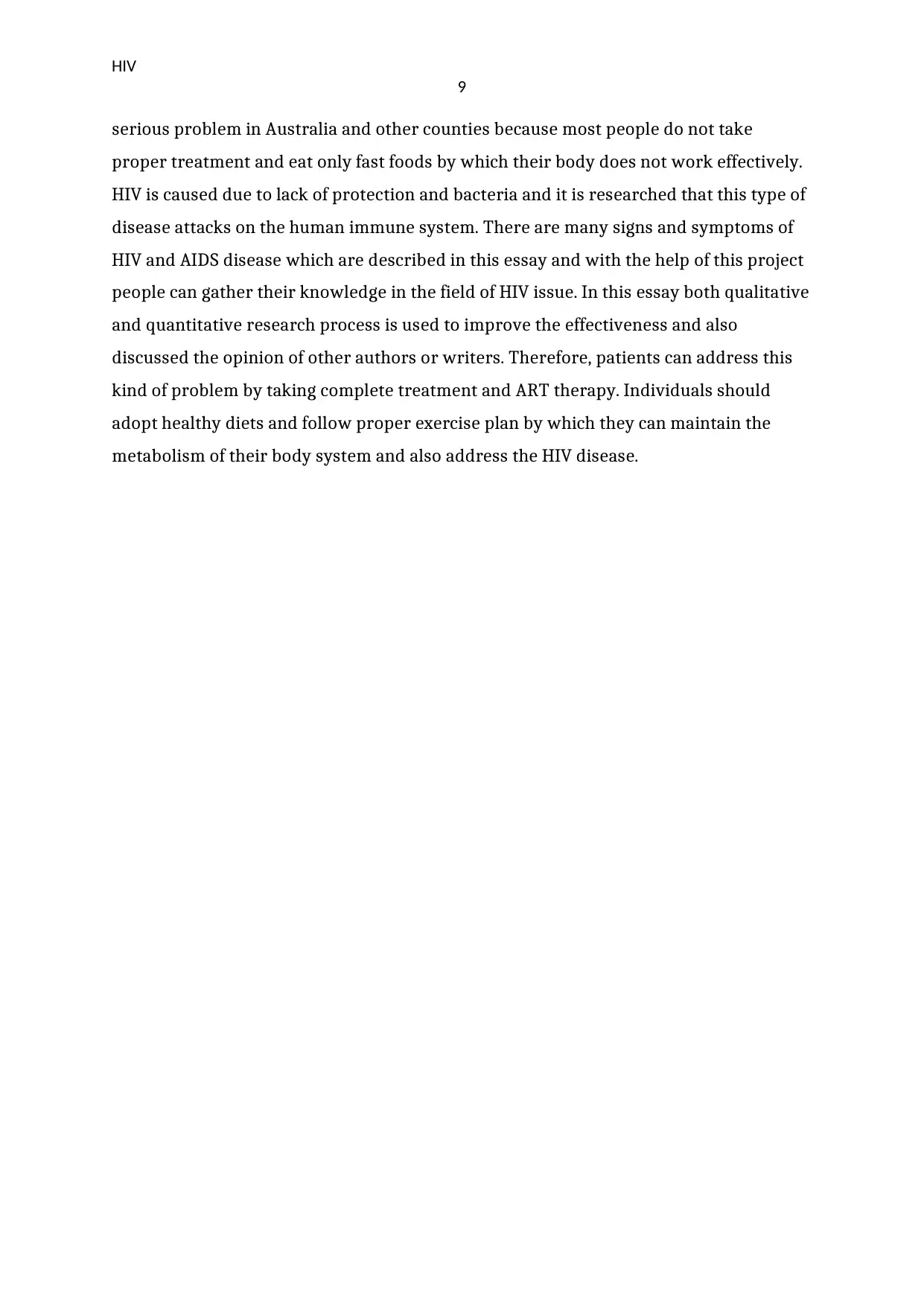
HIV
9
serious problem in Australia and other counties because most people do not take
proper treatment and eat only fast foods by which their body does not work effectively.
HIV is caused due to lack of protection and bacteria and it is researched that this type of
disease attacks on the human immune system. There are many signs and symptoms of
HIV and AIDS disease which are described in this essay and with the help of this project
people can gather their knowledge in the field of HIV issue. In this essay both qualitative
and quantitative research process is used to improve the effectiveness and also
discussed the opinion of other authors or writers. Therefore, patients can address this
kind of problem by taking complete treatment and ART therapy. Individuals should
adopt healthy diets and follow proper exercise plan by which they can maintain the
metabolism of their body system and also address the HIV disease.
9
serious problem in Australia and other counties because most people do not take
proper treatment and eat only fast foods by which their body does not work effectively.
HIV is caused due to lack of protection and bacteria and it is researched that this type of
disease attacks on the human immune system. There are many signs and symptoms of
HIV and AIDS disease which are described in this essay and with the help of this project
people can gather their knowledge in the field of HIV issue. In this essay both qualitative
and quantitative research process is used to improve the effectiveness and also
discussed the opinion of other authors or writers. Therefore, patients can address this
kind of problem by taking complete treatment and ART therapy. Individuals should
adopt healthy diets and follow proper exercise plan by which they can maintain the
metabolism of their body system and also address the HIV disease.
Secure Best Marks with AI Grader
Need help grading? Try our AI Grader for instant feedback on your assignments.
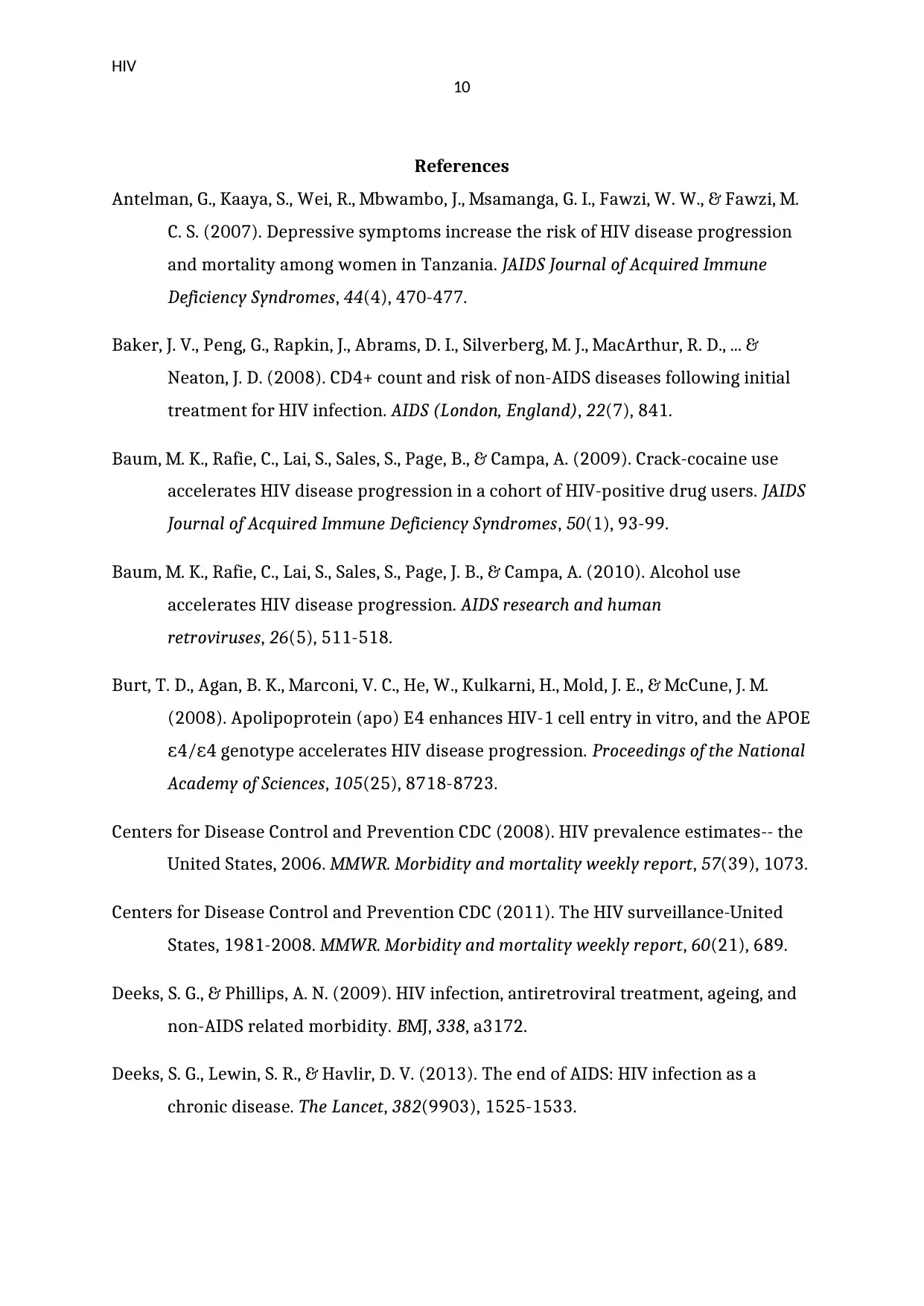
HIV
10
References
Antelman, G., Kaaya, S., Wei, R., Mbwambo, J., Msamanga, G. I., Fawzi, W. W., & Fawzi, M.
C. S. (2007). Depressive symptoms increase the risk of HIV disease progression
and mortality among women in Tanzania. JAIDS Journal of Acquired Immune
Deficiency Syndromes, 44(4), 470-477.
Baker, J. V., Peng, G., Rapkin, J., Abrams, D. I., Silverberg, M. J., MacArthur, R. D., ... &
Neaton, J. D. (2008). CD4+ count and risk of non-AIDS diseases following initial
treatment for HIV infection. AIDS (London, England), 22(7), 841.
Baum, M. K., Rafie, C., Lai, S., Sales, S., Page, B., & Campa, A. (2009). Crack-cocaine use
accelerates HIV disease progression in a cohort of HIV-positive drug users. JAIDS
Journal of Acquired Immune Deficiency Syndromes, 50(1), 93-99.
Baum, M. K., Rafie, C., Lai, S., Sales, S., Page, J. B., & Campa, A. (2010). Alcohol use
accelerates HIV disease progression. AIDS research and human
retroviruses, 26(5), 511-518.
Burt, T. D., Agan, B. K., Marconi, V. C., He, W., Kulkarni, H., Mold, J. E., & McCune, J. M.
(2008). Apolipoprotein (apo) E4 enhances HIV-1 cell entry in vitro, and the APOE
4/ 4 genotype accelerates HIV disease progression.ε ε Proceedings of the National
Academy of Sciences, 105(25), 8718-8723.
Centers for Disease Control and Prevention CDC (2008). HIV prevalence estimates-- the
United States, 2006. MMWR. Morbidity and mortality weekly report, 57(39), 1073.
Centers for Disease Control and Prevention CDC (2011). The HIV surveillance-United
States, 1981-2008. MMWR. Morbidity and mortality weekly report, 60(21), 689.
Deeks, S. G., & Phillips, A. N. (2009). HIV infection, antiretroviral treatment, ageing, and
non-AIDS related morbidity. BMJ, 338, a3172.
Deeks, S. G., Lewin, S. R., & Havlir, D. V. (2013). The end of AIDS: HIV infection as a
chronic disease. The Lancet, 382(9903), 1525-1533.
10
References
Antelman, G., Kaaya, S., Wei, R., Mbwambo, J., Msamanga, G. I., Fawzi, W. W., & Fawzi, M.
C. S. (2007). Depressive symptoms increase the risk of HIV disease progression
and mortality among women in Tanzania. JAIDS Journal of Acquired Immune
Deficiency Syndromes, 44(4), 470-477.
Baker, J. V., Peng, G., Rapkin, J., Abrams, D. I., Silverberg, M. J., MacArthur, R. D., ... &
Neaton, J. D. (2008). CD4+ count and risk of non-AIDS diseases following initial
treatment for HIV infection. AIDS (London, England), 22(7), 841.
Baum, M. K., Rafie, C., Lai, S., Sales, S., Page, B., & Campa, A. (2009). Crack-cocaine use
accelerates HIV disease progression in a cohort of HIV-positive drug users. JAIDS
Journal of Acquired Immune Deficiency Syndromes, 50(1), 93-99.
Baum, M. K., Rafie, C., Lai, S., Sales, S., Page, J. B., & Campa, A. (2010). Alcohol use
accelerates HIV disease progression. AIDS research and human
retroviruses, 26(5), 511-518.
Burt, T. D., Agan, B. K., Marconi, V. C., He, W., Kulkarni, H., Mold, J. E., & McCune, J. M.
(2008). Apolipoprotein (apo) E4 enhances HIV-1 cell entry in vitro, and the APOE
4/ 4 genotype accelerates HIV disease progression.ε ε Proceedings of the National
Academy of Sciences, 105(25), 8718-8723.
Centers for Disease Control and Prevention CDC (2008). HIV prevalence estimates-- the
United States, 2006. MMWR. Morbidity and mortality weekly report, 57(39), 1073.
Centers for Disease Control and Prevention CDC (2011). The HIV surveillance-United
States, 1981-2008. MMWR. Morbidity and mortality weekly report, 60(21), 689.
Deeks, S. G., & Phillips, A. N. (2009). HIV infection, antiretroviral treatment, ageing, and
non-AIDS related morbidity. BMJ, 338, a3172.
Deeks, S. G., Lewin, S. R., & Havlir, D. V. (2013). The end of AIDS: HIV infection as a
chronic disease. The Lancet, 382(9903), 1525-1533.
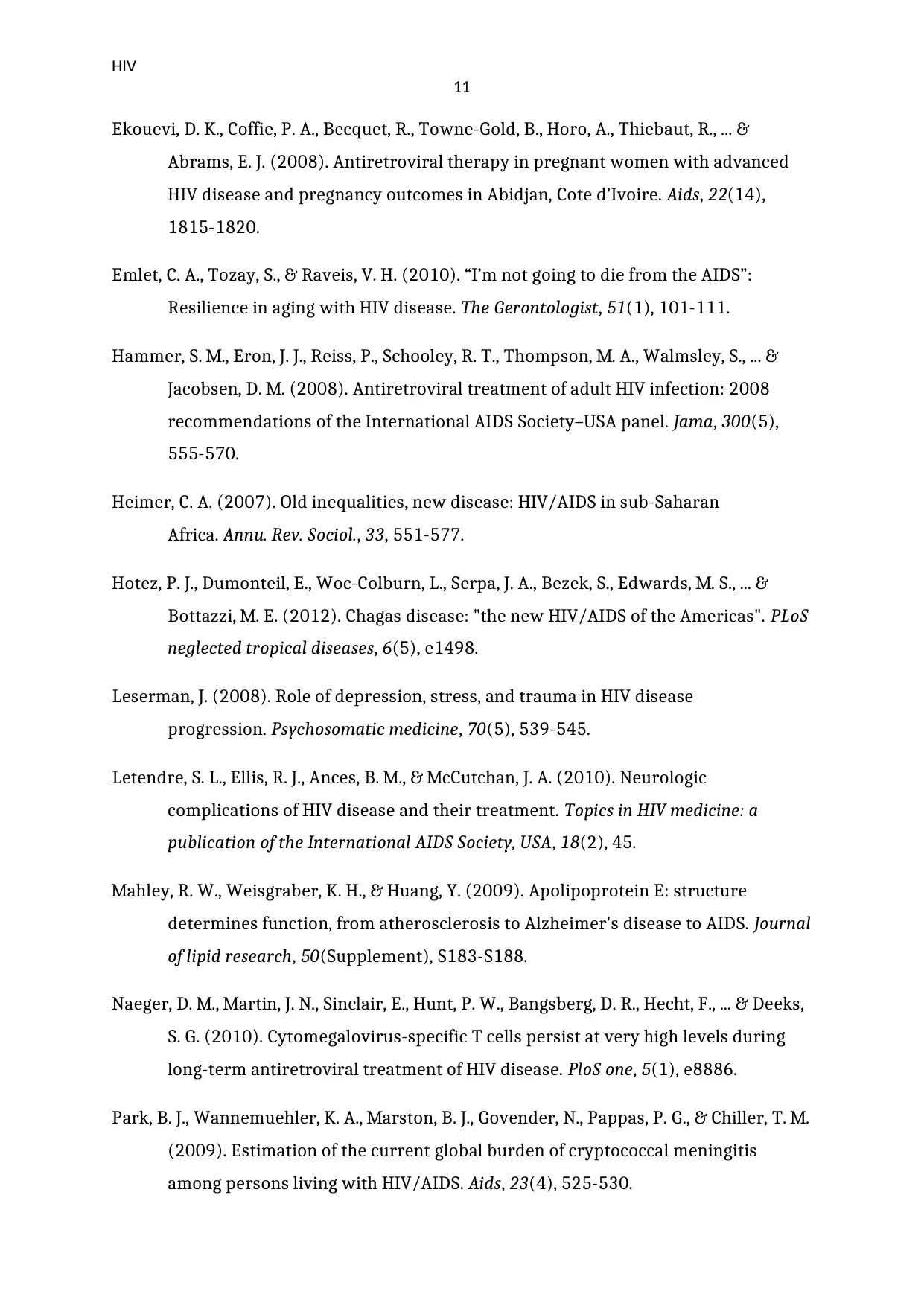
HIV
11
Ekouevi, D. K., Coffie, P. A., Becquet, R., Towne-Gold, B., Horo, A., Thiebaut, R., ... &
Abrams, E. J. (2008). Antiretroviral therapy in pregnant women with advanced
HIV disease and pregnancy outcomes in Abidjan, Cote d'Ivoire. Aids, 22(14),
1815-1820.
Emlet, C. A., Tozay, S., & Raveis, V. H. (2010). “I’m not going to die from the AIDS”:
Resilience in aging with HIV disease. The Gerontologist, 51(1), 101-111.
Hammer, S. M., Eron, J. J., Reiss, P., Schooley, R. T., Thompson, M. A., Walmsley, S., ... &
Jacobsen, D. M. (2008). Antiretroviral treatment of adult HIV infection: 2008
recommendations of the International AIDS Society–USA panel. Jama, 300(5),
555-570.
Heimer, C. A. (2007). Old inequalities, new disease: HIV/AIDS in sub-Saharan
Africa. Annu. Rev. Sociol., 33, 551-577.
Hotez, P. J., Dumonteil, E., Woc-Colburn, L., Serpa, J. A., Bezek, S., Edwards, M. S., ... &
Bottazzi, M. E. (2012). Chagas disease: "the new HIV/AIDS of the Americas". PLoS
neglected tropical diseases, 6(5), e1498.
Leserman, J. (2008). Role of depression, stress, and trauma in HIV disease
progression. Psychosomatic medicine, 70(5), 539-545.
Letendre, S. L., Ellis, R. J., Ances, B. M., & McCutchan, J. A. (2010). Neurologic
complications of HIV disease and their treatment. Topics in HIV medicine: a
publication of the International AIDS Society, USA, 18(2), 45.
Mahley, R. W., Weisgraber, K. H., & Huang, Y. (2009). Apolipoprotein E: structure
determines function, from atherosclerosis to Alzheimer's disease to AIDS. Journal
of lipid research, 50(Supplement), S183-S188.
Naeger, D. M., Martin, J. N., Sinclair, E., Hunt, P. W., Bangsberg, D. R., Hecht, F., ... & Deeks,
S. G. (2010). Cytomegalovirus-specific T cells persist at very high levels during
long-term antiretroviral treatment of HIV disease. PloS one, 5(1), e8886.
Park, B. J., Wannemuehler, K. A., Marston, B. J., Govender, N., Pappas, P. G., & Chiller, T. M.
(2009). Estimation of the current global burden of cryptococcal meningitis
among persons living with HIV/AIDS. Aids, 23(4), 525-530.
11
Ekouevi, D. K., Coffie, P. A., Becquet, R., Towne-Gold, B., Horo, A., Thiebaut, R., ... &
Abrams, E. J. (2008). Antiretroviral therapy in pregnant women with advanced
HIV disease and pregnancy outcomes in Abidjan, Cote d'Ivoire. Aids, 22(14),
1815-1820.
Emlet, C. A., Tozay, S., & Raveis, V. H. (2010). “I’m not going to die from the AIDS”:
Resilience in aging with HIV disease. The Gerontologist, 51(1), 101-111.
Hammer, S. M., Eron, J. J., Reiss, P., Schooley, R. T., Thompson, M. A., Walmsley, S., ... &
Jacobsen, D. M. (2008). Antiretroviral treatment of adult HIV infection: 2008
recommendations of the International AIDS Society–USA panel. Jama, 300(5),
555-570.
Heimer, C. A. (2007). Old inequalities, new disease: HIV/AIDS in sub-Saharan
Africa. Annu. Rev. Sociol., 33, 551-577.
Hotez, P. J., Dumonteil, E., Woc-Colburn, L., Serpa, J. A., Bezek, S., Edwards, M. S., ... &
Bottazzi, M. E. (2012). Chagas disease: "the new HIV/AIDS of the Americas". PLoS
neglected tropical diseases, 6(5), e1498.
Leserman, J. (2008). Role of depression, stress, and trauma in HIV disease
progression. Psychosomatic medicine, 70(5), 539-545.
Letendre, S. L., Ellis, R. J., Ances, B. M., & McCutchan, J. A. (2010). Neurologic
complications of HIV disease and their treatment. Topics in HIV medicine: a
publication of the International AIDS Society, USA, 18(2), 45.
Mahley, R. W., Weisgraber, K. H., & Huang, Y. (2009). Apolipoprotein E: structure
determines function, from atherosclerosis to Alzheimer's disease to AIDS. Journal
of lipid research, 50(Supplement), S183-S188.
Naeger, D. M., Martin, J. N., Sinclair, E., Hunt, P. W., Bangsberg, D. R., Hecht, F., ... & Deeks,
S. G. (2010). Cytomegalovirus-specific T cells persist at very high levels during
long-term antiretroviral treatment of HIV disease. PloS one, 5(1), e8886.
Park, B. J., Wannemuehler, K. A., Marston, B. J., Govender, N., Pappas, P. G., & Chiller, T. M.
(2009). Estimation of the current global burden of cryptococcal meningitis
among persons living with HIV/AIDS. Aids, 23(4), 525-530.
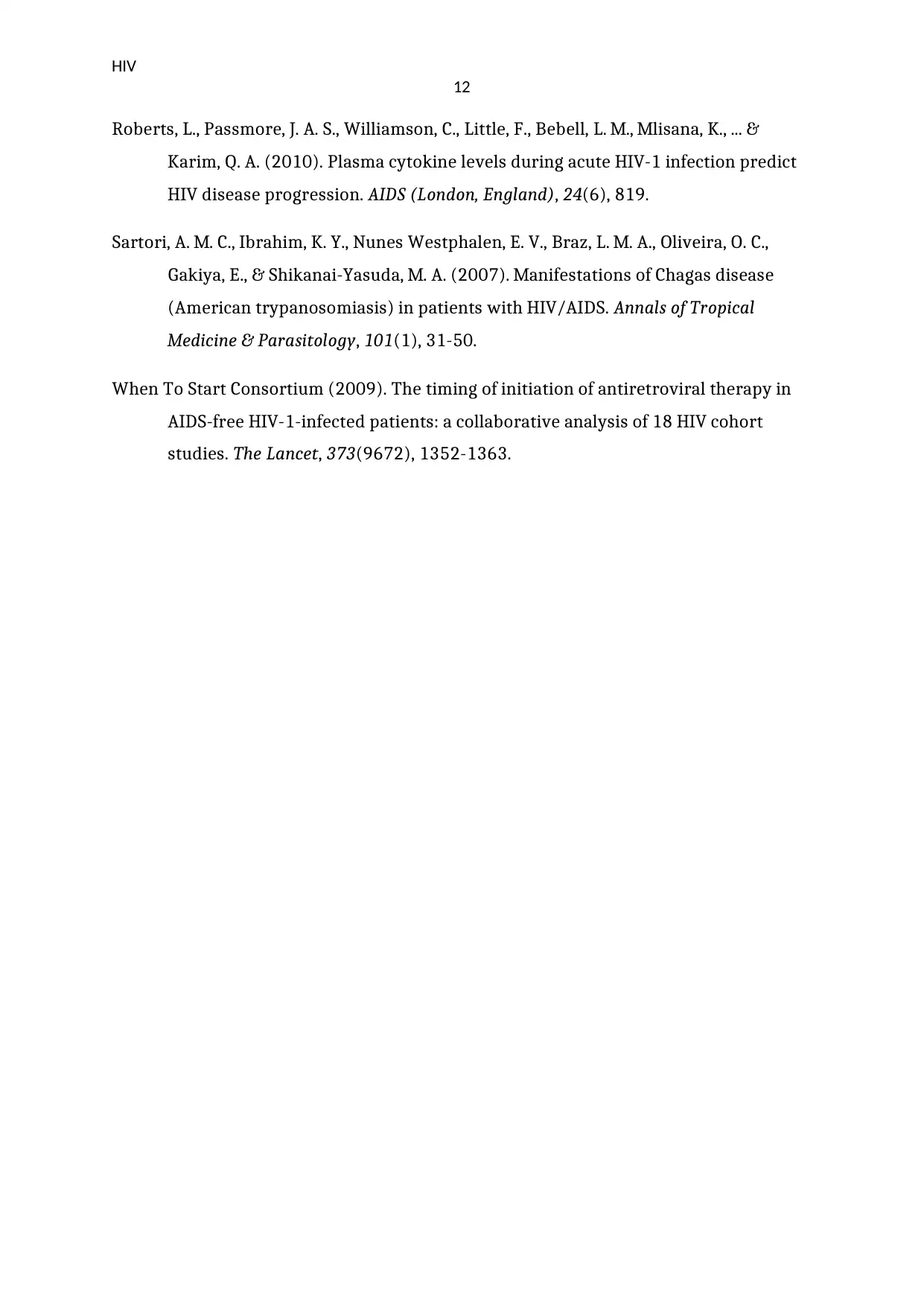
HIV
12
Roberts, L., Passmore, J. A. S., Williamson, C., Little, F., Bebell, L. M., Mlisana, K., ... &
Karim, Q. A. (2010). Plasma cytokine levels during acute HIV-1 infection predict
HIV disease progression. AIDS (London, England), 24(6), 819.
Sartori, A. M. C., Ibrahim, K. Y., Nunes Westphalen, E. V., Braz, L. M. A., Oliveira, O. C.,
Gakiya, E., & Shikanai-Yasuda, M. A. (2007). Manifestations of Chagas disease
(American trypanosomiasis) in patients with HIV/AIDS. Annals of Tropical
Medicine & Parasitology, 101(1), 31-50.
When To Start Consortium (2009). The timing of initiation of antiretroviral therapy in
AIDS-free HIV-1-infected patients: a collaborative analysis of 18 HIV cohort
studies. The Lancet, 373(9672), 1352-1363.
12
Roberts, L., Passmore, J. A. S., Williamson, C., Little, F., Bebell, L. M., Mlisana, K., ... &
Karim, Q. A. (2010). Plasma cytokine levels during acute HIV-1 infection predict
HIV disease progression. AIDS (London, England), 24(6), 819.
Sartori, A. M. C., Ibrahim, K. Y., Nunes Westphalen, E. V., Braz, L. M. A., Oliveira, O. C.,
Gakiya, E., & Shikanai-Yasuda, M. A. (2007). Manifestations of Chagas disease
(American trypanosomiasis) in patients with HIV/AIDS. Annals of Tropical
Medicine & Parasitology, 101(1), 31-50.
When To Start Consortium (2009). The timing of initiation of antiretroviral therapy in
AIDS-free HIV-1-infected patients: a collaborative analysis of 18 HIV cohort
studies. The Lancet, 373(9672), 1352-1363.
1 out of 13
Related Documents
Your All-in-One AI-Powered Toolkit for Academic Success.
+13062052269
info@desklib.com
Available 24*7 on WhatsApp / Email
![[object Object]](/_next/static/media/star-bottom.7253800d.svg)
Unlock your academic potential
© 2024 | Zucol Services PVT LTD | All rights reserved.





